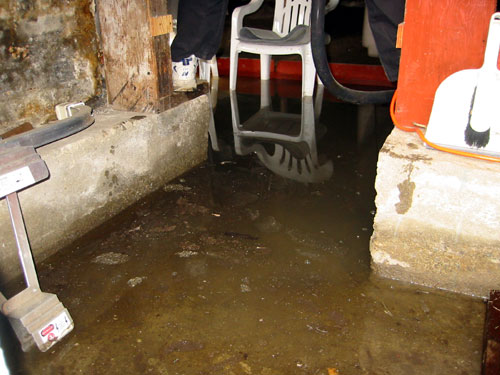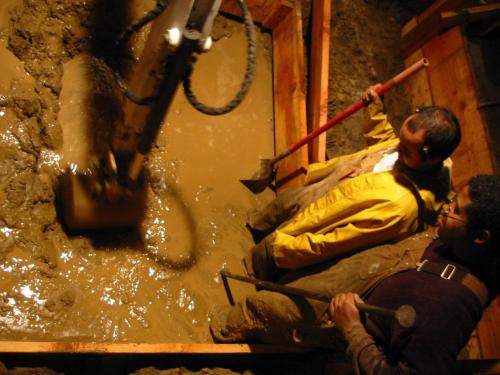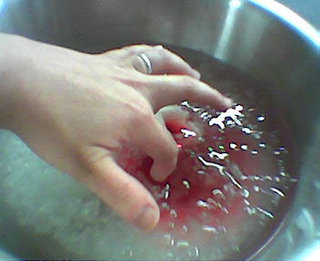High Water
It was pretty obvious when you went under the house pre-foundation replacement that there were a serious water problem under there. How serious? This is what it looked like after a rain:

That's six inches of standing water, if you need some sense of scale.
We had a dirt sump dug out, but the sides collapsed regularly, and the process was very manual, involving one of us going down into the basement in waders and turning the sump on.
Contractor A, on seeing this photo and hearing our repeated worries about high water, told us in early December of 2004 that he was going to wait for the water to go down as it does in the summer before digging the foundation out.
A few weeks later, he said he didn't have enough work and would start on our job. He and I spent an hour on the phone one day talking about how he intended to dewater the site. He would put in three dewatering wells around the perimeter, drain the water down to below the excavation level, and then dig high and dry.
That would have been great if he had done it, but instead, he started digging those dewatering wells and found the ground too wet and the going too difficult... so he stopped. That's right. The most important job site safety measure he had to take and he gave up because it looked like he was going to have to call in an excavator and he didn't want to pay a little extra for that. The one thing that he could have come to us and said, "I need more money because dewatering is going to be harder than I thought" and we would have paid him more, and he just threw up his hands and gave up.
Instead, he just soldiered ahead with the excavation in six inches of standing water. Later, as we were digging out from under the mess he made, we would find his half-assed attempts at dewatering wells tossed at the back of the site along with the other trash he left everywhere. A possum nested in the pipe and raised a baby there.
In the meantime, we were getting funding for expanding the scope of the job to include excavating for a basement. In early February Contractor A gave us a contract with a set price to do the foundation, and we signed it. At this point there were no drawn plans, but he was willing to write up a bid that took a gamble on what those plans would look like. It's also worth noting that the permits for even the initial scope of the foundation job -- the simple replacement -- had not been approved. But Contractor A had started working, anyway.
Well, he'd started something. I don't know if you could call it working.

It wasn't until a month after this photo was taken that Contractor A even mentioned that there was a problem with the water under our house. He claimed, throughout the lawsuit, that he had notified us, but oddly that was the one piece of documentation he simply could not produce. We sure didn't have a copy of it.
In his deposition, which is sworn testimony, he claimed that he had notified us of a concealed condition under our house on the 14th of February. That was the day before the picture above was taken. If he had notifed us then, he would not have still been digging the next day. In fact, it is highly irregular for a contractor to continue to do something that will exacerbate a dangerous situation after he has realized it is dangerous.
He also claimed he was working so hard to try to save our house (guffaw) that he was unable to keep track of what was happening or to write out a note telling us there was an issue. But in the time between this photo and when he finally did notify us, he met with us several times and gave us several written change orders on unrelated areas of the house. In addition, his personal calendar shows he was working on other jobs.
So either Contractor A was trying to destroy our house (I doubt that), or he was an idiot (bingo!) who screwed up by failing to dewater the site, then lied and lied and finally lied under oath (who'd-a guessed?) in order to try to cover up his idiocy.
The first we heard of this situation being bad (remember I was 250 miles away at Cal Poly at the time, so the only person on the job site was Noel, whose construction experience is pretty thin) was when Contractor A called us while Noel was visiting me on March 10 and told us the structural engineer had been out to the site and instructed him that grade beams would be required because (he didn't tell us but we later found out) he had over-excavated. He then mentioned that the engineer had said we needed to get a soils engineer in, but he thought it was not critical and would add too much to the cost of the job. The engineer, he said, had said the soils engineer was optional.
We were coming home from walking on the beach with the dog after a long day of crits (the studio equivalent of a final exam, only much more stressful). We had pulled off into a little lay-by to take the call together, and after we hung up the phone we had a brief argument about whether we should hire a soils engineer. In the end we called the structural engineer to get his input and hear it straight from him.
His reaction was one of horror. He told us that hiring a soils engineer was not at all optional at this point, that he would not continue on the job if we didn't do so. He told us there were parts of the soil under our house that felt like walking on a waterbed. This was the guy who, when we asked him initially if we should hire a soils engineer, told us it wasn't really done in residential jobs (it's not) and that while he was not a soils engineer, he'd never heard of soil problems in Alameda.
So. We'd just caught Contractor A in a lie. A big lie. A lie that was just the beginning of the many lies he would tell.
We found a soils engineer who could come out to the site, and booked him for the first possible day when we could all meet. That was two weeks later. And then we sat on pins and needles for two weeks (actually, then I took a bunch of exams and dealt with more of Contractor A's lies, we did a long-delayed trip to visit family for part of my brief school break, and we both consumed amazing quantities of valium).
Thinking back on that period, there is one funny and telling thing. I actually cut the end off of one of my fingers in studio in early March. They were able to reattach it and I have full function in that finger today, but I had great difficulty finishing my studio project and another class project where I had to build something. It was also intensely painful. But I keep forgetting that had happened (and how do you forget that?) because the foundation swindle was consuming so much of my energy. So if you ever need to have an accident involving an X-Acto blade and your left hand, I recommend being conned at the same time. You'll forget it ever happened. Honestly, folks, I keep forgetting that this ever happened:

Because everything with the house was so much more awful. Perspective, eh?
Also, when you cut off the end of your finger they stick your hand in a bowl of ice, which hurts far more than the cut itself. Then they can just glue the tip back on with superglue. Seriously. That's what it was invented for. Modern medicine makes miracles look like side shows. That is all.
Technorati Tags: construction, demolition, digging, flooding, foundation, foundation replacement, injuries, legal action, renovation horrors, stupid, water
posted by ayse on 04/13/10